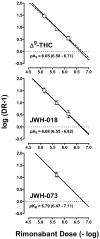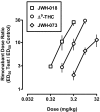JWH-018 and JWH-073: Δ⁹-tetrahydrocannabinol-like discriminative stimulus effects in monkeys
- PMID: 21965552
- PMCID: PMC3251026
- DOI: 10.1124/jpet.111.187757
JWH-018 and JWH-073: Δ⁹-tetrahydrocannabinol-like discriminative stimulus effects in monkeys
Abstract
Products containing naphthalen-1-yl-(1-pentylindol-3-yl) methanone (JWH-018) and naphthalen-1-yl-(1-butylindol-3-yl) methanone (JWH-073) are emerging drugs of abuse. Here, the behavioral effects of JWH-018 and JWH-073 were examined in one behavioral assay selective for cannabinoid agonism, rhesus monkeys (n = 4) discriminating Δ⁹-tetrahydrocannabinol (Δ⁹-THC; 0.1 mg/kg i.v.), and another assay sensitive to cannabinoid withdrawal, i.e., monkeys (n = 3) discriminating the cannabinoid antagonist rimonabant (1 mg/kg i.v.) during chronic Δ⁹-THC (1 mg/kg s.c. 12 h) treatment. Δ⁹-THC, JWH-018, and JWH-073 increased drug-lever responding in monkeys discriminating Δ⁹-THC; the ED₅₀ values were 0.044, 0.013, and 0.058 mg/kg, respectively and the duration of action was 4, 2, and 1 h, respectively. Rimonabant (0.32-3.2 mg/kg) produced surmountable antagonism of Δ⁹-THC, JWH-018, and JWH-073. Schild analyses and single-dose apparent affinity estimates yielded apparent pA₂/pK(B) values of 6.65, 6.68, and 6.79 in the presence of Δ⁹-THC, JWH-018, and JWH-073, respectively. In Δ⁹-THC-treated monkeys discriminating rimonabant, the training drug increased responding on the rimonabant lever; the ED₅₀ value of rimonabant was 0.20 mg/kg. Δ⁹-THC (1-10 mg/kg), JWH-018 (0.32-3.2 mg/kg), and JWH-073 (3.2-32 mg/kg) dose-dependently attenuated the rimonabant-discriminative stimulus (i.e., withdrawal). These results suggest that Δ⁹-THC, JWH-018, and JWH-073 act through the same receptors to produce Δ⁹-THC-like subjective effects and attenuate Δ⁹-THC withdrawal. The relatively short duration of action of JWH-018 and JWH-073 might lead to more frequent use, which could strengthen habitual use by increasing the frequency of stimulus-outcome pairings. This coupled with the possible greater efficacy of JWH-018 at cannabinoid 1 receptors could be associated with greater dependence liability than Δ⁹-THC.
Figures





References
-
- Balster RL, Prescott WR. (1992) Δ9-Tetrahydrocannabinol discrimination in rats as a model for cannabis intoxication. Neurosci Biobehav Rev 16:55–62 - PubMed
-
- Boisse NR, Okamoto M. (1978) Physical dependence to barbital compared to pentobarbital. IV. Influence of elimination kinetics. J Pharmacol Exp Ther 204:526–540 - PubMed
-
- Breivogel CS, Childers SR. (2000) Cannabinoid agonist signal transduction in rat brain: comparison of cannabinoid agonists in receptor binding, G-protein activation, and adenylyl cyclase inhibition. J Pharmacol Exp Ther 295:328–336 - PubMed
Publication types
MeSH terms
Substances
Grants and funding
LinkOut - more resources
Full Text Sources

